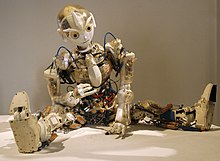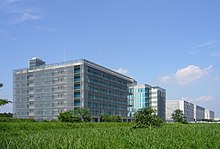Tokyo University
| Tokyo University | |
|---|---|

|
|
| founding | 1877 |
| Sponsorship | state |
| place | Bunkyō (Tokyo), Japan |
| management | Makoto Gonokami |
| Students | 28,753 |
| Employee | 2429 full-time 175 part-time |
| Networks | IARU , IAU |
| Website | www.u-tokyo.ac.jp |
The University of Tokyo ( Japanese 東京 大学 , Tōkyō Daigaku , abbreviated: Japanese 東 大 , Tōdai ) is a state university in Bunkyō and is generally regarded as the university in Japan with the greatest prestige.
The university has five locations and ten faculties with a total of around 28,000 students, 2,100 of whom are foreigners. Though practically every academic branch is taught at the Tōdai , it is known for its law and literature faculties. Many important Japanese politicians and top officials in the ministries are Tōdai graduates .
The main campus is located on the site where the Kaga-yashiki city residence of the Maeda , the rich liege princes of Kanazawa , was located in the Edo period . The most famous entrance to the university campus, the “Red Gate” ( Akamon , 赤 門 ), dates from this time. The pond surrounded by green also belonged to the same residence and is now called “Sanshirō pond” after the hero of a novel by Natsume Sōseki . The symbol of the university is the ginkgo flower because of the many trees on campus.
history
The university was founded in April 1877 by the Meiji government , whereby the faculties of law, natural sciences and humanities from the former "Kaisei School Tokyo" ( Tōkyō Kaisei Gakkō 東京 開 成 学校 ) and the faculty of medicine from the "Medical School Tokyo" ( Tōkyō Igakkō 東京 医 学校 ) were formed. The Tōkyō Kaisei Gakkō in turn went back to the "investigative authority for foreign writings" ( Bansho Shirabesho ) founded in 1811 , which was subordinate to the "Astronomy Office" ( Temmonkata 天文 方 ) of the Tokugawa Shogunate founded in 1684 . The "Tokyo Medical School" emerged from the "Smallpox Vaccination Authority " ( Shutōjo 種痘 所 ) founded in 1858 . Another predecessor facility was the Confucian "Academy Shōheizaka" ( Shōheizaka Gakumonjo 昌平 坂 学問 所 ) founded in 1797 on the site of the “Holy Hall Yushima” ( Yushima Seidō ).
Above all, the work of German medical professionals in setting up the medical faculty has not been forgotten to this day. The pioneers Benjamin Karl Leopold Müller and Theodor Hoffmann (medical officer) came to the country shortly after the Franco-Prussian War in 1871. The language of instruction was initially German, the textbooks continued to be written in German for a long time. Japanese doctors who are well versed in language also translated important lectures. In addition to Müller, Erwin Bälz and Julius Scriba were honored with bronze busts on the university grounds while they were still alive. German lawyers, educationalists and other professionals followed.
In 1886 the University of Tokyo was first renamed Imperial University ( 帝国 大学 , Teikoku Daigaku ) as the only university in Japan at the time, and in 1897 with the establishment of Kyoto University as the second imperial university, it was renamed Imperial University of Tokyo ( 東京 帝国 大学 , Tōkyō Teikoku Daigaku ). By the end of the Second World War there were a total of nine imperial universities . In 1947, after Japan's defeat in World War II, the university got its first name again.
In 1923 the university was badly damaged by the great Kanto earthquake . The Rockefeller Foundation gave funds for reconstruction. The buildings from this period clearly show an English college style.
The University is a member of university networks Association of Pacific Rim Universities (APRU), Association of East Asian Research Universities (AEARU) and BESETOHA (together with Peking University , Seoul National University and Hanoi University). Since 2006, the university has been a member of the International Alliance of Research Universities (IARU) .
As part of the 1964 Summer Olympics , the 4000 m cross-country run in the modern pentathlon was held on the university grounds.
Locations
- Hongo Campus in Bunkyō, Tokyo Prefecture
- Komaba Campus in Meguro, Tokyo Prefecture
- Kashiwa Campus in Kashiwa, Chiba Prefecture
- Shirokane Campus in Minato, Tokyo Prefecture
- Nakano Campus in Nakano, Tokyo Prefecture
Faculties

Today the University of Tokyo has ten faculties:
- medicine
- Engineering
- Humanities
- Natural sciences
- Agricultural Sciences
- Economics
- Liberal Arts
- pedagogy
- Pharmaceuticals
- law Sciences
All students attend the Faculty of Liberal Arts for two years, some students stay there for interdisciplinary studies. There are five locations, but most students attend two of them: Komaba campus for two years and then Hongo campus for two years.
The university also has many research institutes in Japan, with many former research institutes of Tokyo University now being independent institutions.
Graduates
Many well-known Japanese graduated from Tokyo University. Empress Masako enrolled as a law school student after graduating from Harvard University . After a year, however, she had to deregister because she had passed the state examination to become a diplomat. Her father, Hisashi Owada , a former judge of the International Court of Justice , graduated from law school.
Other graduates are e.g. B. ( family name first):
- Judges of the International Court of Justice : Oda Shigeru , Tanaka Kōtarō (also professor there), Owada Hisashi, Iwasawa Yūji
- Prime Ministers: Kishi Nobusuke , Miyazawa Kiichi , Nakasone Yasuhiro , Satō Eisaku ( 1974 Nobel Peace Prize Winner), Yoshida Shigeru , Hatoyama Yukio
- Scientists: Bunji Sakita (theoretical physicist), Esaki Reona ( Nobel Prize Winner in Physics 1973), Hasumi Shigehiko (former Rector, Cultural Studies), Itō Kiyoshi ( Mathematician ), Kikkawa Keiji (theoretical physicist), Kunihiko Kodaira ( Fields Medal Winner 1954), Kondō Jun (theoretical physicist), Koshiba Masatoshi (Nobel Prize Winner in Physics 2002), Sasaki Takeshi (now Rector, Political Science), Nambu Yōichirō (Nobel Prize Winner in Physics 2008), Negishi Ei-ichi (Nobel Prize Winner in Chemistry 2010), Yoro Takeshi (ex. Professor of the medical faculty, also writer of bestsellers), Kajita Takaaki (Nobel Laureate in Physics 2015), Ōsumi Yoshinori (Nobel Laureate in Physiology or Medicine 2016)
- Writers: Kawabata Yasunari ( Nobel Prize Winner 1968), Mori Ōgai , Natsume Sōseki (known for the image on the 1000 yen note), Ōe Kenzaburō (Nobel Prize Winner 1994)
- Others: Horie Takafumi (chairman of Livedoor ), Nishida Kitarō (philosopher), Inoue Kiyoshi (historian), Ōkawa Shūmei (still at the time of the Imperial University of Tokyo), Takahata Isao (director), Takata Mayuko ( actress ), Uekusa Kazuhide ( economist ), Yuasa Takashi (international lawyer ), Nobuchika Mamine (international lawyer), Ayaka Nishiwaki (singer, perfume ), Naoya Kihara (poker player)
See also
Web links
- University of Tokyo website (Japanese, English)
Individual evidence
- ↑ https://www.u-tokyo.ac.jp/en/about/president.html
- ↑ 東京 大学 (学生 数) 学生 ・ 研究生 ・ 聴 講 生 数 . Retrieved June 14, 2007.
- ^ The University of Tokyo [Organization Number of Students / Personnel] . Archived from the original on June 20, 2007. Retrieved June 14, 2007.
- ^ List of IAU Members. In: iau-aiu.net. International Association of Universities, accessed August 4, 2019 .
- ↑ [東京 大学 の 歴 史] 沿革 略 図. University of Tokyo, accessed July 8, 2009 (Japanese).
Coordinates: 35 ° 42 ′ 48 ″ N , 139 ° 45 ′ 44 ″ E


